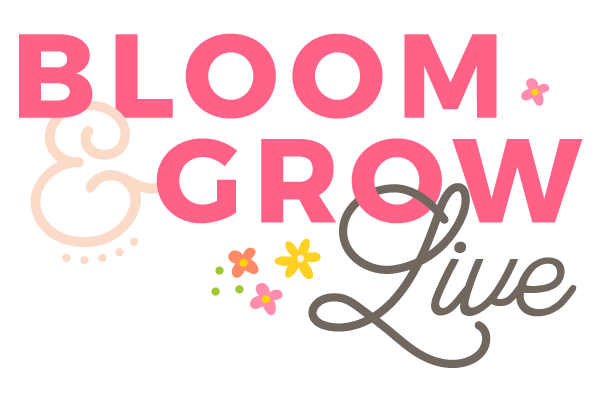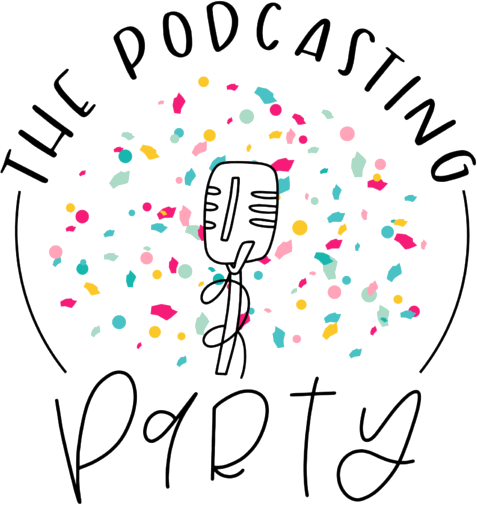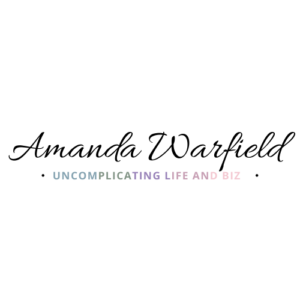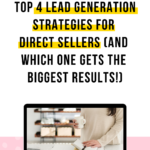

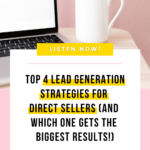
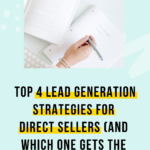
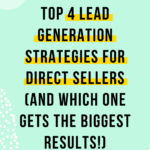
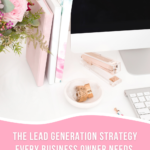
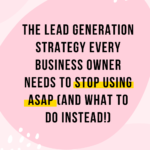
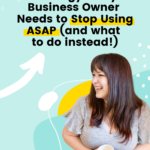
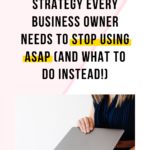
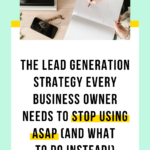
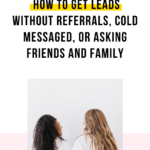
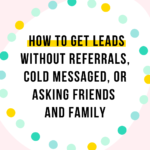
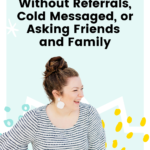
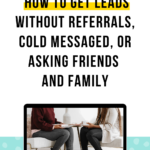
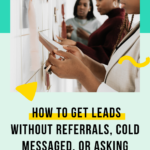
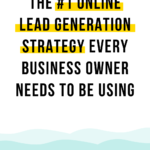
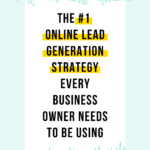
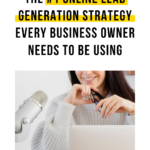
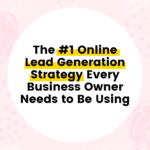
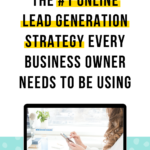
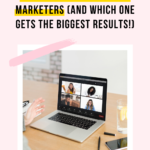
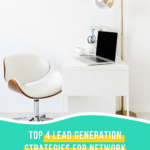
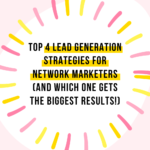
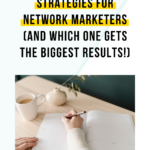
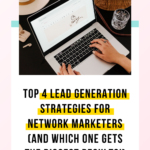
Leads are the lifeblood of your business. Without them you can’t book and you definitely can’t sell. But if your lead generation strategy leaves you exhausted, burnt out, and broke then you’re going to hit a wall and your flow of leads will eventually stop.
So which strategies are worth your time and energy? That’s exactly what I’m covering in today’s episode! We’ll talk about the two strategies that are costing you more than they’re making you, which strategy can work but only when done right, and the most proven, most effective lead generation strategy every business owner needs to be using.
Listen now!
Prefer to read, blog post style?
Episode Transcript
026. Which Lead Generation Strategies Are Worth Your Time (and Which to Skip!)
0:00
Alright, so I don't feel like I need to start this episode by convincing you that lead generation matters. Because once you run out of leads, you don't have a business anymore. And I think most people, rather than not being aware of that are actually painfully aware of it, it almost haunts us. in those early stages of business, when we don't know where the next lead is coming from, or if you're even later in those stages of business, and the strategies
0:27
you're
0:28
using, aren't working anymore, they're not converting or they're getting you leads who just aren't actually interested in your product, they're attracting the wrong people. So I'm not going to try and convince you that lead gen matters, I know that you already know that. Instead, what I want to do today is I want to talk about some of the common types of lead generation. So the lead generation strategies that are most common in the network marketing and direct sales space, and I want to go through them and I want to rank them from not best to worst, but highest return on investment to lowest return on investment and highest effort to lowest effort. Because the truth is, is you can't sell to people who don't know that you exist. And you also can't sustain a business that completely burns you out. So we've got to find that sweet spot of a lead generation strategy that does take effort but isn't totally exhausting, or burning you out, and also attracts the right people who are excited to be a part of your business. And so I sort of alluded to this a second ago, but when you're looking at lead generation strategies, there's really two different scales that you can actually measure these based on, how much effort does it take a lot of effort or a little bit of effort? And then also, how big is that return on investment? Does it have a high return on investment, or does it have a low return on investment, and in the sweet spot that I was talking about is we want something that is a low amount of effort and a high return on investment. And there's nothing wrong with a lead gen strategy that has a high amount of effort and a high return on investment. But the sweet spot, the one that we all need to make sure we have at least one of these strategies in place is the one that's going to take minimal effort, and also is going to give the highest return on investment. So today, we're going to cover four different lead generation strategies, we're going to cover one that's a low effort, but also a low return on investment. So something that's not worth your time. And you might be doing this right now, which is why I want to warn you of it, we're also going to talk about one that's a high amount of effort and still a low return on investment, again, not worth your time. And then we're going to cover two that are a high effort, but also a high return on investment, something that's worth your time when done right and in the right context. And finally, we're going to talk about the lead generation strategy that falls in the sweet spot, which is low effort, but high return on investment. This is the one that everybody needs to be using in their business. Everyone needs to have at least one lead gen strategy that costs minimal amount of effort, minimal dollars, minimal investment into it, but brings a high yield that brings in lots of leads, you can also have your high effort high return but you've got to at least have one low effort high return to have a sustainable strategy. So we're going to cover those in order from basically the two that are not worth your time to the two that everyone should be doing. Ending and wrapping it up with low effort high return, because that's the one I want you to take away from this episode and start doing immediately. If you want a business that's going to last a lifetime. So let's go ahead and dive right in. So I already gave this away by saying that I wanted to start with the one that was not worth your time. So there's not going to be any surprises here. But the lead gen strategy I want to start with is messaging your Facebook friends, and this could account for Instagram as well. So messaging, random people on Facebook or Instagram, even if they're friends of you, or followers, even worse if they are not your friends and not your followers. So I want to do pros and cons for each of these so that it's really clear what the positives are but also where the downfalls are for every single lead gen strategy we're going to talk about. So the pro for messaging your Facebook friends is that ideally, these are people who actually do have a positive, strong relationship with you if this is done right. So that by itself might mean that people are more likely to say yes, but here's the caveat to that, which kind of segues us right into the cons. And the caveat to that is that in order for that to be true, these people that you're messaging can't just be people that you're friends with on Facebook or just be people that you
4:53
happen to know in real life in addition to knowing you through some connection Big or small, they also need to have expressed interest in your product and business specifically and explicitly. And so what I mean by that is they need to have said, messaged me about your product I'm interested in buying from you. This is something I'm curious about, I have a question something like that they are not a warm lead, until they've expressed interest in the business. Because until they've expressed interest in the business or the product, they're just your friend. And being a friend doesn't equal being a lead. So like I said, this segues right into the cons. And the first con is that this strategy can burn bridges. Fast, fast, fast. So if it's out of the blue, if you're messaging somebody, and they haven't expressed specific and explicit interest in the product that you're selling, or your business, then they are going to wonder why you're messaging them. Or worse, they're not going to wonder why you're messaging them. But they're going to make assumptions about why you're messaging them. And that assumption is most likely going to be that you're all about the sale, that you look at them with dollar signs in your eyes. And while that may not be true, that is the result that comes from this strategy. And so with that this isn't sustainable, it burns more bridges than it builds, and you're working with a list of people that will eventually run out. And so that's the second con here is that you might look at your friends list and message 100 people or 200 people, but as soon as that list runs out, where are you getting those new leads from? This isn't a lead generation strategy, it's just a cold messaging strategy, you're not actually generating new leads, you're just looking at every connection that you currently have, and trying to get something out of them. The result is that people feel used, bridges are burned, and you have a really low return on investment. But it costs you a lot of time and a lot of mental energy. Because every time somebody says no, that is going to wear on you, it's exhausting to hear no all the time. And this particular strategy has a really high chance of you hearing no or not hearing back at all, which is a burned bridge. So here's the conclusion about messaging, Facebook, friends, messaging, Instagram, friends or followers, it's not worth your time, it takes way too much effort, and it doesn't have a high enough chance of a positive outcome, which leaves you burnt out, it burns bridges between you and your friends or your acquaintances that you may want to have those relationships in the future, but they now look at you as a salesperson, or every time they think of you. So this strategy does a lot more damage than it's worth. So I want you to take that energy and put it somewhere else, that's going to give you a higher return on the energy that you're putting out there. So next, I want to talk about a lead generation strategy. That's low effort, which is great. But it does still have a low return on investment. And that's lead boxes. If you're in the beauty industry, you may have heard them called facial boxes. But the universal term is going to be a lead box. And this is something that you might go into, say a nail salon or a pizza place and you see a little box on the counter, it says something to the effect of enter to win a bla bla bla or enter to get a blah, blah, blah. And then people fill out a little scrap of paper and they drop it in the box. One of the more modern ways to do this is that it'll be just like a picture frame with a sign and it says text so and so to enter and text a key word. So that is another version of this, but they're the exact same thing, they have the exact same results and effort. So let's talk about that. Let's start with the pros. So the pros of this is that it actually is really easy. And it really is minimal effort. It's the kind of strategy that you sort of set it and forget it to some extent, because you create your box one time and you put it out one time and then you leave it for a week or two weeks, there is a lapse of time when leads are coming into the box while you're not physically doing something. So the biggest effort is one going out and creating the boxes but then placing them so you have to go and talk to the business owner and get them to let you put it in, which usually isn't too hard if you're targeting the right types of businesses, and then you're getting leads while you're not standing there. So that's great.
9:31
That's where the low effort comes in. But there is always the follow up which is now reaching out to all of those leads who are lukewarm. These are not hot leads because they really don't know much about your business. They just know about the free thing that you're giving away. But they're still warm leads because they are interested in whatever the thing is whether you're giving away a free beauty experience if you're in the beauty industry or you're giving away a cooking class as maybe a Pampered Chef consultant Something like that. So you know, they're interested in the category of products, but they still don't know that this is a business. And so there's not they're not super hot leads, these are lukewarm. So the Pro is that it's pretty easy, it's relatively minimal effort. And then the other Pro is that it's a relatively simple way to break into new locations in your area. So the town next door, or a couple blocks away that sort of thing. So if you're finding that you're getting a lot of leads in just one area of your town, you can go and place a lead box in a different area, and more than likely, you'll get leads from that specific area. So it's an okay in person lead generation strategy for getting into new areas. But let's go ahead and talk about the cons for a second, the biggest problem with lead boxes is that they're often really low quality leads. And the hot leads are few and far between, you tend to get a pretty mixed bag, because you never know who's actually putting their information in, it's almost impossible to actually target your ideal customer through a lead box, because you don't know who's going to see it and who's going to put their information in. So if you're in the beauty industry, for example, and you put your lead box in a nail salon, certainly you're going to get people who are interested in getting their nails done, and therefore by association may also be interested in the beauty industry. But you don't know if they're young, if they're old, if their parents if their family people, if they're college students what their financial status is, you don't know anything about them, and there's no way to actually narrow it down. And so the result is that you find yourself wading through deep waters to find the people who are really worth connecting with. There's also an after effect of lead boxes that can happen when they're not done right. So often I'll see the verbiage on lead boxes being shared in a very misleading way where it says something like, enter to win. But then the consultant on the other side, the rep who's putting the lead box out messages, every single person who entered and they all win, which means nobody's winning, it wasn't a contest, it was just a gather as many people as possible and contact all of them, which is fine. There's nothing wrong with it being exactly that there's only something wrong with it being exactly that if you're telling people otherwise. So you cannot say enter to win. And then contact everyone and tell everybody that they won because it is dishonest. And the result of that is it diminishes trust, before you ever actually get a chance to connect with someone and have them potentially become your customer. So you have to be really, really specific and careful about the way that you're wording these so that you don't put yourself in a position to be misleading the person who's putting their name into your lead box. So avoiding words like win, and contest because it isn't a contest, and nobody's winning. It's just they get this if they give you their contact information. So it's just really important to be super honest, if you're going to use this lead generation strategy, and approach it from an ethical standpoint, so that you don't end up in a situation where you're booking a party with someone they realize what happened. And now they don't trust you because they feel like you've baited and switched on them. Someone who feels that way is not going to buy. So the last thing you want to do is approach this from an unethical standpoint, and actually burn bridges with people who could have potentially been a great lead for your business. So in conclusion, lead boxes actually aren't a bad strategy, they do have a decent return on investment. It's not a higher return on investment. And it does require a little bit of effort, but it is relatively low effort. So we've got a low effort lead gen strategy, the effort really comes from creating the lead box and putting it out and then the follow up but actually getting the leads into the box is pretty low effort. But the yield is not high, you often will find yourself wading through waters to find the right people. So you might get 10 leads, you might text all 10 of them, but get five responses and then two people actually book and or one person actually books and then that person could potentially cancel. And it's just it's not a high return because it takes quite a bit to actually find the people within your lead box that entered into your lead box who are a good fit for your business and are actually willing to spend money with you later on. So,
14:43
conclusion not a bad strategy. Don't expect a high yield don't expect a higher return on investment. This is best when paired with another lead generation strategy which is low effort and high yield. So we always want to have at least one low effort high yield strategy. And that can be paired with the high effort, high yield, or low effort, low yield strategies. So this is something you want to pair with something that's low effort, high yield. Alright, our third lead gen strategy that we're going to talk about today is referrals. So referrals are an interesting one, because oftentimes, we think of referrals as our hottest leads, right? We've got someone who told us, hey, my friend would totally be interested in what you have to offer. And when done right, they actually can be really hot leads. And when I say done, right, what I mean is that your customer who's giving you the referral has prepped the person they're referring to you, before they ever get to you. So this is the difference between someone making a list of everyone in their phone contacts and saying, sure, you can contact them versus somebody saying to you, Hey, I just talked to my friend, so and so I really talked to you up, I think they're a great fit, they know you're going to contact them, would you mind reaching out like they'd be a great fit for you. The second type of referral that I just mentioned, there, that's the one that's going to be a hot lead, you know, that person is almost guaranteed to buy or book, because the friend that is your customer has prepped them, they've done the selling for you, they've already got their friend on board with being a part of your business or becoming your customer. The problem with having a list of random contacts given to you by your customer is this, those people do not know that you're going to contact them. And I don't know about you. But I find it incredibly frustrating when random people text me asking me to book with them, or sell me something, and I have no relationship with them before. And this is for the exact same reason that cold messages don't work. Because I know that I'm a number in your eyes. And I bet you feel the same way. If someone just randomly messages you and says, Hey, you want to book a party with me, that's really uncomfortable, it makes you look at that person and say, I know that the only reason you're ever contacting me is because I might potentially give you my money. And so the result is that you're burning bridges before you ever even lay the first brick down. The other problem with referrals, which are a high effort, low return lead generation strategy that takes a lot of effort gets a low return on investment. The other problem with this strategy is that it can be really hard to get a hold of people, as I was just alluding to, it's awkward when people randomly text you or call you and want to sell you something or book you for something that you had no interest in or even knowledge about before that day. And so because it can be hard to get ahold of people, you wind up spending a lot more time attempting to find people than you do actually connecting with people. And so that's where the low return comes in, and where the high effort comes in. And the other reason this is also considered a really high effort lead gen strategy is because you often have to be in person for this to actually work in any capacity, and being in person. So whether that's a party or a one on one appointment with someone, being in person takes a lot of time and it takes a lot of energy you have to drive there, you have to actually spend time with that person, it takes a lot of energy to communicate with that person. And there's always going to be time before and after that sort of a wasted time, right when you're prepping for this. Because we can't book appointments back to back, right, we can't go you know, one to two o'clock and then have a two o'clock appointment, we have to have a buffer in there. And so it leaves a lot of blank space and time that's unused. So that makes this a really high effort lead gen strategy,
18:56
and paired with the fact that it's not a high yielding strategy, because not everyone is going to be actually interested in your product. Not everyone is going to actually respond when you contact them. It doesn't make this a strategy that's really worth your time and energy. Now, does that mean you should never ask for referrals? Or that you should not accept referrals from your customers or encourage them to refer their friends to you? No, it absolutely does not what it means that you need to approach referrals a little bit differently. So often, I'll see people asking their customers to make them a list of just random people from their contacts so that they can call all of them or text all of them and cross their fingers that someone will respond and book or purchase. At this point. We not only know that doesn't work very well, but we also know that that's exhausting and doesn't have a high yield. So instead what you want to do is build a culture where your customers are excited. I needed to go out and tell their friends about you without you having to actually prompt them. Or with very little prompting, you want to create a culture where your customers are going to their friends and telling them about you. And they're sending their friends to you. Rather than telling you about their friends and sending you to their friends, you want to make sure that you're attracting people not chasing people. And so you want to flip your referral strategy if you're going to use a referral strategy, so that you're actually getting your customers to send their friends to you already excited about what you have to offer and your product, rather than getting lists from your customer and then chasing after all of their friends. So those are the biggest and most common low yield lead generation strategies. We have referrals, we have messaging people on Facebook, or Instagram, and we have lead boxes, all of these have a very low yield, where it requires more effort than it's worth to actually get people to book with you or to buy with you. The result of this is that you wind up spending a lot of energy for a very little and low return on investment, very few leads, who actually ever turn into a sale. So let's go ahead and talk about what our high return on investment, lead generation strategies are the most common, most popular, most proven lead generation strategy is going to be a lead magnet. So a lead magnet is very basic, it's very simple. It can be anything that you give away for free, that provides value to your audience, in exchange for that person giving you their contact information, and then permission to continue marketing to them in the future. And lead magnets are all around us. So here are some examples. So if you go on a clothing website, and they offer you a discount in exchange for your email address, that's a lead magnet, you go on to a restaurant and they say text this number for a free appetizer, they've given you a free appetizer in exchange for your cell phone number. If you go on a website, and they say download this free guide to learn how to do xy and z, give us your email address, we'll send it to you that is a lead magnet, you've exchanged the education that comes from that guide for permission to market with you and your email address. So just always look for exchanges. And you'll start to notice lead magnets. Anytime you're exchanging a piece of contact information, a phone number and email address, etc. for something that you're getting for free in return, that's a lead magnet, that is that business trying to attract people like you who are genuinely interested in their product by giving away something for free and something of value. Now we talked about high effort, low return and low effort, low return lead generation strategies. So now we're talking about high effort, high return and low effort high return lead generation strategies. And lead magnets can fall into both depending on the type of lead magnet that it actually is. So an example of a high effort. But high return lead magnet would be something like a workshop or a challenge or something like that, where you have to actively work the entire time
23:24
that you're generating those leads and continuing to connect and nurture those leads. An example of a low effort high return lead generation strategy is going to be something like a free guide that you give away or a pre recorded class, anything where you're not specifically working continuously throughout the entire process. But these work for the exact same reason. So let's talk about that. Let's talk about the pros. So lead magnets provide so much value to your audience. When done right. The whole purpose of a lead magnet is to really hone in on who is it that you want to attract to your business? What type of person do you want to attract to your business? And what problems are you trying to solve, and then you provide something that actually helps them either solve the problem completely, or head in the right direction to start solving that problem. Usually, this turns into teaching something so you might provide a free guide if you're in the beauty industry on how to do winged eyeliner. If you're selling bags and purses and organizational tools like that, you might give them a free tutorial of some kind, whether it's a guide, or it's a video on how to organize their closet or their kitchen, you're teaching them something that helps them move past their pain point. If you sell cooking products or food items like Pampered Chef, that sort of thing. You might teach a cooking class or give away a free recipe so the free recipe would be one of the low effort high yield lead magnets were teaching a live cooking class would be high effort, but still high yield. And again, the sweet spot that we want to start with is always going to be low effort, high yield, or high return on investment, we all need to have, no matter what type of business you're in, you all need to have at least one consistent lead generation strategy. That's minimal effort that gets you a really high return on the effort that you do put in. And then you can, once you have that in place, pair that with something that's high effort and higher return. So there's nothing wrong with doing a little bit of work, right, we're not afraid of a little work.
25:42
But you can't do that all day, every day, you can't put in 100% maximum effort all the time. So you need to have something that only requires a minimal amount of effort, as you're consistent everyday lead gen strategy. And then you supplement that with something that's a higher effort, and still a higher return. One of the other reasons that lead magnets works so incredibly well whether they're high effort or low effort, is because they build trust unbelievably fast. Anybody who is learning from you, anybody who you're solving a problem for you're bettering their lives in some way, that's going to build a whole lot of trust between the two of you, because they're looking at you as someone who helped them. They're looking at you, as someone who knows how to solve the problems that they're going through, they're looking at you as someone who gets them who understands them. And that's who we buy from the people we feel understood by the people that we feel connected to. And lead magnets foster that connection, and they build that trust. Some of the other lead generation strategies we talked about today actually burn those bridges and diminish the trust before you ever even actually connect with the person. And that is part of why there's such high effort. Because when you're burning bridges before you ever contact someone, there's really no chance that they're going to actually be interested in working with you. Or it's going to take a lot of effort to rebuild that trust. But lead magnets work the opposite way they build trust, before you ever even mention a product or a sale or booking for a party, they show your lead from the get go before they ever connect with you that you're not all about the sale that your primary motivation is helping them and supporting them and serving them. Now we talked about high effort lead magnet strategies, something like a live challenge or a workshop or a course. But let's talk for a second about low effort lead magnet strategies, because that's the one I want you to walk away today, thinking about getting started with and working on implementing in your business. So this is going to be something like a free guide, something that you create one time, and then your only effort being put into it is just telling people about it, just letting people know that it exists and inviting them to enjoy it for free. That by itself, the fact that you put the effort into create it one time, and then you don't have to continue editing and reinventing the wheel on a regular basis. That by itself makes this a really low effort lead generation strategy. But it's also one of the most flexible lead generation strategies. And the reason for that is because there's an unlimited number of ways that you can market it. Basically, any way that you could potentially say, comm download this thing, it's free, I think you'll love it, that could be a way that you market it. So you could do that on Instagram stories. You could do that on Instagram lives or Facebook Lives. You can just post on social media, whether it's instagram, twitter, facebook, whatever it is, you can network in Facebook groups, you can network in person and verbally tell people about it. You could write blog posts, and then invite people to download it at the end of the blog post. You can do the same thing in an Instagram post or a Facebook post by teaching something that's like blog post style. And then at the end say, hey, if you like this, go download my free thing, I think you'll enjoy it. And if you get to more advanced strategies, you can even use Facebook ads to amplify how far your reach is with your lead magnet. But as you can see, there's no one way to do this. So if you think about using a lead box, well that can only be done one way you have to put it in a location and then step back and wait for people to come rolling in. But when you're using a lead magnet, you're not just putting it out in just Facebook groups. You're not putting it out in just Instagram, you now get to share it anywhere and everywhere. So when you find that one maybe isn't working as much or you're not enjoying one or your ideal customer isn't on Instagram But instead they're on Facebook, you can easily switch it up. And you're never going to run out of ways that you can promote your lead magnet and invite people to come and download it. And because you're solving a really specific problem, you're going to attract people who are hot qualified leads in your business. So instead of getting a mixed bag, because you put your lead box in a pizza, place down the road or a nail salon, and you don't know who's putting their name in, instead of getting random names and numbers from your customers, BB from friends, they haven't actually spoken to in a long time, or people who are not interested in your product at all. But your customer was just trying to get you a list of names, you're attracting people whose problems you can solve, because you're already solving one of them, you're basically out there saying, hey, anybody who has this specific type of problem, who's concerned with this specific type of thing, I can actually help with that. So come to me. And so now you are attracting people who very specifically have problems you can solve have needs that you can serve, rather than people who may or may not actually have a need that you can support them with. This makes lead magnets and extremely high yield, high return on investment, lead generation strategy, for the effort that you're putting in, you're really attracting qualified people who you know, are interested in some way shape or form in your business, does that mean that 100% of the leads that come into your business are going to buy from you? Absolutely not, definitely not. That's just not possible. And you cannot ever expect that to happen. But it does mean that a higher percentage of the people who come into your business as a potential lead, are going to be interested in making a purchase from you or continuing the relationship with you. It also means that even if someone doesn't buy from you today, they're more likely to come back and make a purchase from you later on. So even if someone isn't the perfect lead and ready to make a purchase, right this second, you now have an opportunity to continue building a relationship with them. So that in the future when they're ready for whatever you have to offer, they actually think of you as the first person that they could buy from.
32:19
And I want to be fair, so I do want to talk about the biggest con of using lead magnets. And this is really, really important. The biggest con of using a lead magnet is that you need to view yourself as a personal brand and really acknowledge your own value as a business owner, not just as a rep for your company, lead magnets are all about how you personally can serve your audience. So you're not saying come and get a free sample of my product or get a free party with me, those are not lead magnets. While they technically fall into the give something away for free in exchange for contact information. They're very, very, very young, low yield ways to actually get leads through a lead magnet strategy. Lead Magnet strategies work best when you're giving something as a human as a person, and you're educating and you're teaching and not just making it all about your product. In order to do that, you need to recognize that you as a business owner are a personal brand separate from your company, that even if you sold a different product, you personally would still have something to offer to your audience. So if you think about your business right now, and you think about yourself right now, and you're like, you know, I do not know what I personally bring to the table to my business. I'm just like everybody else, I want you to take some time and really think about what is it that makes you unique? Why you why your business? Why should I purchase your product from you, and not the person down the road, and I don't want to hear I have great customer service, I'll really take care of you. Because those things are all nice, but they don't affect the final product, which is buying the product. So if I'm trying to buy a new purse from you, your customer service might be great. But if I can get a sale from the girl down the road, maybe I'm just gonna go to her even if she has bad customer service. Because once the products in my hand, what do I care service doesn't matter, right? So what is it aside from your customer service and your deep love for your customers that actually makes you unique? More than likely that's going to be the way that you educate and teach and solve problems for your audience. So if you sell things like purses and bags and boxes and bins and things like that, your special secret sauce, the thing that you might teach about that makes you unique and special might be home organization. If you sell food or cooking utensils and things like that for the kitchen, your secret sauce might be working with people on the key No diet, or your secret sauce might be teaching people how to cook authentic Italian cuisine. Like you've got to have that really specific thing that makes you personally unique. If you sell skincare products and beauty products, you could potentially teach people how to do really high end like fancy makeup looks. Or you could potentially be known for teaching people about how to treat advanced aging, it's all about knowing what is the unique thing that you can give to your audience, in addition to your product, products, fantastic, you wouldn't sell it if it wasn't, your product works, you wouldn't sell it if it didn't. But your product can be bought from the girl down the road, too. So you've got to look at yourself and really recognize, yep, I sell this product. But I'm more than that. I also help you X, Y and Z. And that x, y and z is how you're going to approach your lead magnet. What can you teach that's related, but not specifically your product that's going to attract people into your business. And the reason I list this as a con is because that's not an always an easy shift to make by yourself. It's not always simple to step back after years of being told that your product is the center of the universe, and shift to see yourself as the center of your business. And if you're not in that mindset, yet, where you understand your own personal value as a business owner, you just have to do a little bit of work to really dig deep, and look at your business and analyze what you're doing and say what is it that I either already bring to the table, or if you're not currently bringing that little something extra look at what you love and how you can support your customers and maybe what they need, and figure out what can be your secret sauce, like what is that extra thing that differentiates you from the girl down the road that sells the same product.
36:59
So that is the biggest con when it comes to using lead magnets, you have to acknowledge your own value as a business owner. And then the pros of lead magnets is that it's very low effort with a high return on investment. There are tons of ways that you can actually use lead magnets to attract people. So it's unlimited potential, you build trust extremely fast, which means that the actual process of going from lead to customer is going to be simpler. And it's also something that can be done both online or in person. So you can verbally invite someone to come and download your lead magnet. Or you can share online and invite people to come download your lead magnet, making it one of the most versatile types of lead generation strategies out there. And finally, lead magnets can be both a high effort, high yield and a low effort low yield. So you have options, you can start by getting that consistent low effort, high yield, lead generation strategy into place. And then you can supplement it as needed. With a second lead generation strategy. Maybe you do it a couple times a year or once a month, something like that, where it's high effort, but still very, very high return on investment. So really quick recap. Before we wrap this up. We started with our low effort, low return on investment lead generation strategy, which is lead boxes, we started with a high effort low return on investment lead gen strategy, which is messaging Facebook or Instagram friends, we have our high effort, low return on investment, lead gen strategy of referrals. We have a high effort high return lead generation strategy, which is going to be lead magnets in this style of workshops or webinars or live trainings, that sort of thing. And then finally, we have our gold that we all need to have in our businesses. The one type of lead gen strategy that everybody absolutely has to have in order to have a business that lasts more than a year that lasts a long time and actually brings in money and is profitable. And that is a low effort, high return on investment lead gen strategy, which is going to be a lead magnet like an instant download or a guide or anything that you can give away for free that you get in exchange somebody's contact information, but provides value to your audience. So I hope that you enjoyed this episode and you're able to not only walk away with clarity on which lead generation strategies are going to be most worth your time and energy and which are not worth your energy and time, but also a renewed sense of excitement and hope for your business. Now that you have a clear path to know exactly where you should spend your time to get the biggest bang for your buck. And if you're ready to start using lead magnets in your business But you're just not sure where to start. I'd love to invite you to my free leads for a lifetime five day challenge. During this five day challenge, I'll hold your hands as we cover how to stay laser focused on attracting high quality qualified leads to your business, how to transform your leads life, so that when you ask for the sale, it's a no brainer for them to say yes, how to bridge the gap so that you can convert your leads into paying customers how to level up your personal brand image so that people instantly trust what you're saying and what you have to offer, and how to automate your leads follow up strategy so that you can build forward momentum in your business and continue nurturing those relationships so that people come back and buy from you over and over and over again. By the end of this challenge, you'll have a clear lead generation strategy and the tools you need to actually put it on autopilot without having to ask for referrals without contacting friends and family on Facebook or cold messaging your entire friends list on Instagram. This is your opportunity to fast track your lead generation strategy without having to start from scratch or figure it out alone. So I hope I'll see you there. This challenge is completely free and you can grab your ticket at anchor design co.com slash challenge and I can't wait to see you there bye for now.
LISTEN, SUBSCRIBE & REVIEW ON:
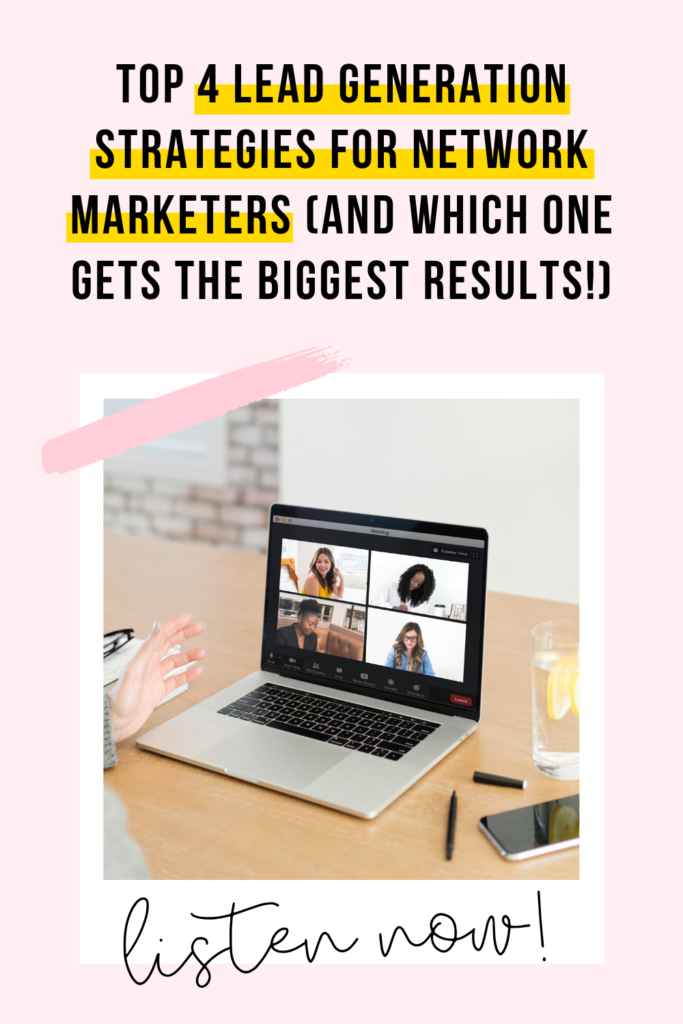
The Highlights:
Short & sweet episode highlights
Which lead generation strategy is the biggest money pit
The 1 lead generation strategy with the lowest effort but highest return on investment
The most versatile way of getting new leads so you don’t get burnt out
How to get started attracting leads that you know are 100% interested in buying your product
The Links:
Links mentioned in this episode
Join the FREE Leads for a Lifetime Challenge at AnchorDesignCo.com/challenge
Follow us on Facebook
Join the Build it Like a Business Community
Connect on Instagram

Free download!
Get your FREE ticket to the Leads for a Lifetime 5 Day Challenge! By the time this challenge is over you'll have a working lead magnet that attracts highly qualified leads who are excited about what you have to offer… without having to ask for referrals, contact friends and family, or cold-message your Facebook friend's list.
Looking for support?
Search for an answer in our recent episodes!





